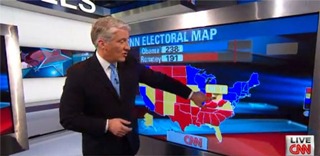Touch Screen Displays and Interactivity in the Newsroom
| Date: 10th September 2013 |
| Market: Broadcast |
| Technology: Data Visualization, Displays, Interactive, Motion Graphics, Touch Screen |
As a software company that straddles both the event and the broadcast markets, at Ventuz we’ve observed an interesting trend: Broadcasters are borrowing technology from the event market for the setup of their newsroom studios.
The event and AV industry is a hotbed of innovative technological ideas, shaping the expectations of thousands of attendees at exhibitions, shows, galas and so forth. Large projections, video walls, interactivity – whatever is new and hot, the event industry will be the first to try and use it for visitor experiences. Increasingly, broadcasters are starting to borrow ideas from the events market to make their in-studio setups more appealing for audiences. But how do they do it, and how is it done well?
Sadly, touch and multi-touch technology is oftentimes viewed as a mere gimmick and not understood for the value it can add to a program. What most newsroom touch installations lack, is a clear vision of how this technology can be important for their audience. In many cases, engineers seem to have simply transitioned traditional on-air graphics onto a touch screen. Instead of some off-camera person triggering graphics on cue, the host triggers the graphics by touching points on the display.
If this is done well and an intuitive touch interface is created, this can be a nice gimmick for a show. Naturally it is essential that the presenter knows the interface by heart and is never confused by what is happening on the screen. Slips and failures of the touch application in a live broadcast are the worst that can happen.
But even if this is provided, how do you use the full potential of the technology? The answer is easy: By using the real-time nature to help visualize thinking processes as they are happening instead of following a pre-defined script or schedule.
To read the full article with examples and in-depth explanations, visit the CGW website.



